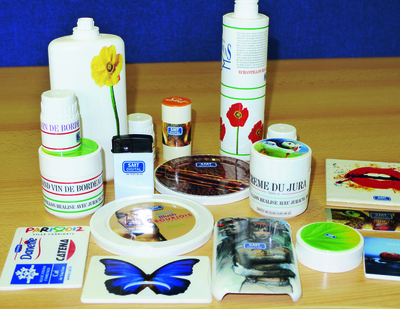Industrial Inkjet managing director John Corrall talks about the opportunities and economics for commercial printers in inkjetting decorative effects directly onto products.
Direct product decoration is one potential new market for commercial printers to explore new revenue opportunities, even though inkjet is still in its infancy. It is a difficult technique to get right, and requires huge technical expertise, but means there is plenty of variety because virtually every project is a one-off.
Of course, personalisation and customisation do not require direct product decoration. A product can be personalised by adding a variable label or shrink-sleeve or even an in-mould label. One limitation of that route is obviously that the product is not really being customised at the last moment. The series of labels or sleeves must be printed first. So you could not use that technique to make a one-off personalised smart-phone cover with a picture of your favourite kitten (and even if you did – would it be physically tough enough to withstand daily wear and tear?).
But direct product decoration is also taking off where the run lengths might be thousands or tens of thousands – for example, printing bottles or tubes. Right now, we at Industrial Inkjet are working on a large number of projects with some major industry players. Direct print of tubes seems to be the ‘next big thing’, but why is that? The simple answer is economics. No new technology ever takes off unless the economics work.
So what makes direct print more economic than the use of a label or sleeve? We realised what was happening about two or three years ago. To a tube manufacturer, the difference in cost between a digitally printed label and printing direct to the tube is not simply the cost of the label material. It is actually the profit of the label convertor that makes the difference. The tube manufacturer buys his labels from an outside label print company. If he starts to print direct to the tube then this will be an in-house process. His cost now is only the ink used. Roughly speaking we are seeing costs-per-print of between 10 and 30% for direct print over digitally printed labels.
In any application with very high volumes and no variation, printing digitally versus conventionally will end up more expensive. For every application we have to work out the break-even volume for the customer and make sure this makes sense to him. The good news is that with direct print the cost-per-print is much lower and so the break-even volume becomes much higher. Inkjet stays economically viable into some serious run-lengths.

We have all seen what Coca Cola did with printing individual names directly on bottles. For food packaging, the logistics of that sound like a nightmare, but we already have one customer, in a different market, who has fully adopted it. It is an internet company where you can buy novelty goods – particularly mobile phone covers – and have your own photo or image printed directly on them. It is hands-off production – no human intervention. Robots pick the part that is printed by inkjet. This is a run-length of one item.
There is a feeling in the ‘design’ industry that the desire to buy expensive branded goods is fading. What comes next is personalisation. So you do not any longer want a bag with Gucci on it – you would probably prefer a bag with your kitten on it!
Car number plates, sponges, perfume bottles, ear defenders and coffee cup sleeves are other examples of direct product decoration.
Here at IIJ we have visitors coming to us every day who have no experience of inkjet – but think it might be useful for their production process. It is our job to find out if that is true for them. As well as the obvious print sample work (we produce over £300,000 worth of samples every year alone), we spend a long time talking about how the inkjet system would need to fit into their production line. We talk about issues like pre-treatment of the material, ink adhesion, resolution and print quality as well as post-print curing of the ink.
We provide complete solutions for the successful design and implementation of Konica Minolta’s industrial printheads, which are renowned for high print quality and reliability.
We offer advice on any aspect of the use of inkjet technology in industrial applications, with direct product decoration a recognised strength of ours.





